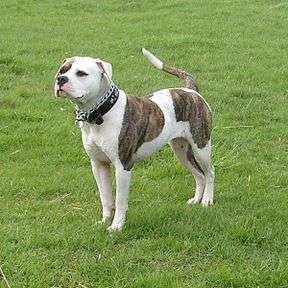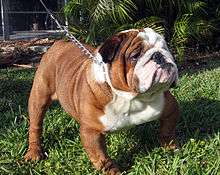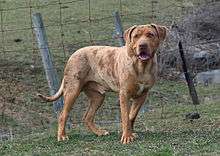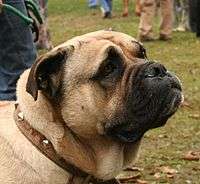Bulldog breeds
Bulldog breeds is a collective name for various breeds of dog of a particular type, also known as bull breeds.
Baiting sports
The blood sport of dog-baiting animals has occurred since antiquity, most famously in the Roman Colosseum, a direct precursor to the modern Spanish sport of bullfighting. In the post-Roman era, baiting, per se, was most closely associated with the English, who pursued it with utmost earnestness. The pastime flourished, reaching the peak of its popularity during the sixteenth century.
Extinct breeds
Bullenbeisser
The Bullenbeisser, also known as the German Bulldog, was a breed from Germany known for its strength and agility. It was an ancestor to the modern Boxer breed. The breed is now extinct.[1][2]
Old English Bulldog
The first historical traces of bull-baiting occur in the time of the regency of King John. Enraged steers, specially bred for their aggressive nature, were used to test the keenness of dogs. A collar around the bull's neck was fastened to a thick rope about three to five metres long, attached to a hook, then fastened to an embedded stake that turned, allowing the bull to watch its antagonizer.
The dog's goal in the attack was to pin and steadfastly hold on to the bull's nose, which is its most sensitive spot. If the dog gripped tightly, the bull became completely tractable. The practical purpose that pre-dated the sport was that the working "butcher's dogs" rendered the semi-wild cattle available to the butcher for slaughter without human injury. To avoid this attack, experienced fighting bulls lowered their heads as much as possible in the direction of the attacking dog, protecting their noses and meeting the attacker with only their horns, tossing the dog into the air. The dog reciprocated by staying low to the ground as it crept towards the bull. These tactics resulted in a specialized breed in the form of the now-extinct original Old English Bulldog.
This breed was extremely compact, broad, and muscular. Modern oral history describes a particular characteristic of the breed as a lower jaw that projected considerably in front of the upper jaw, which made possible the strong, vice-like grip. This is highly doubtful since all modern working catch dogs have a level or reverse scissors bite. The story continues that the nose was deeply set, which allowed the dog to get enough air as it gripped the bull. A certain small amount of "layback" of the nose may possibly have been desirable, but a more important characteristic would have been a large nasal opening for airflow. The contemporary recreation of this breed of lore is called the Olde English Bulldogge.
Toy Bulldog
The Toy Bulldog, also known as the Miniature Bulldog, was a breed of small bulldog that averaged 40 pounds (18 kg) in weight. Many of them were pushed out of Britain during the mid to late 19th century, seen as a threat to the Bulldog, and were extinct by the early 20th century.
Recognized breeds
American Bulldog
The American Bulldog is larger in size. There are historically considered to be two types of American Bulldog, the Johnson type (also known as the Classic or Bully type) and the Scott type (also known as Standard or Performance type), named after the breeders who were influential in developing them, John D. Johnson and Allen Scott. Most current American Bulldogs have ancestry from both lineages.
English Bulldog
The English bulldog of today has developed since the initial bull-baiting days, inasmuch as characteristics of the breed (such as the underbite, size of the head and width of shoulder) have been accentuated by selective breeding. The term "Bulldog" is the correct name for the breed, although they are often referred to as "English Bulldogs" or "British Bulldogs".
Boxer
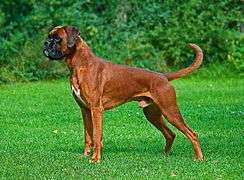
Bred from the Bullenbeisser and the Old English Bulldog, the Boxer was originally used for bull- and bear-baiting.
French Bulldog
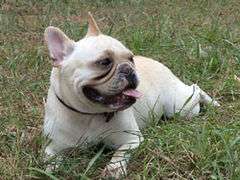
The French Bulldog emerged as Bulldogs that were bred with Toy Bulldogs by the artistic community in Paris. They average 10 to 12 kilograms (22 to 26 lb). Their physical appearance is characterized by naturally occurring 'bat ears' that are pointy and stick straight up. Their tails are naturally short, not cropped. Otherwise, their body shape is similar to that of a Bulldog.
Olde English Bulldogge
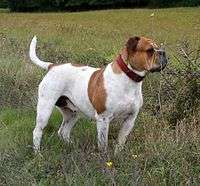
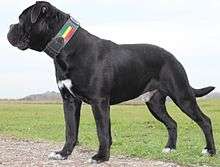
The Olde English Bulldogge began as a re-creation of the British Regency-period "bull-baiter", and was developed by David Leavitt of Coatesville, Pennsylvania in the 1970s. The Olde English Bulldogge is a muscular, medium-sized dog of great strength, stability and athleticism. It is well-balanced and -proportioned with no exaggerated features. It has the appearance of a dog capable of doing its original job of bull baiting. A selection from the Olde English Bulldogge breed is recognized by the United Kennel Club as of January 2014. David Leavitt continues to develop the original breed under the name Leavitt Bulldog.
Alano Español

Also known as the Spanish Bulldog, the Alano Español is native to Spain. With a similar coat color to the Perro de Presa Canario, the Spanish Bulldog got interbred with the Old English Bulldog from the 1600s. This breed was bred to guard, hunt and herd. It is a social dog breed with excellent skills for guarding much like the American Bulldog, with a similar body type. This breed is also lesser known than the American Bulldog and the Old English Bulldog.
Alternative bulldogs
In response to the health problems associated with many short-muzzled dog breeds, particularly the Bulldog, a number of breeders offer alternative bulldogs, some of which are true-breeding lineages, and some are first-generation crosses between two established breeds. Some of these breeders aim to recreate an extinct or nearly extinct type of dog. These include:
- Catahoula bulldog, a crossbreed between the Catahoula Leopard Dog and the American Bulldog
- Ca de Bou (a.k.a. Perro de Presa Mallorquin, Mallorca Mastiff, and many other names), a nearly extinct breed since World War II that has been saved, after a fashion, by crossbreeding.
References
| Wikimedia Commons has media related to Bulldog breeds. |
- ↑ Royal Canin. "Canine Health Nutrition - MAXI Dog Origin (Boxer)". Retrieved 2007-08-04.
- ↑ SarahsDogs.com. "Sarah's Dogs: Breeds: Boxer". Retrieved 2007-08-04.
- Brearley, Joan McDonald (1985). The Book of the Bulldog. Neptune, NJ: TFH Publications. ISBN 0-86622-027-5.
- Jenkins, Robert; Ken Mollett (1997). The Story of the Real Bulldog. Neptune, NJ: TFH Publications. ISBN 0-7938-0491-4.
- Zwettler, Marlene (2013). The Great Book of Bulldogs, Bull Terrier and Molosser. Amazon Digital Services. ISBN 9783844239225.
